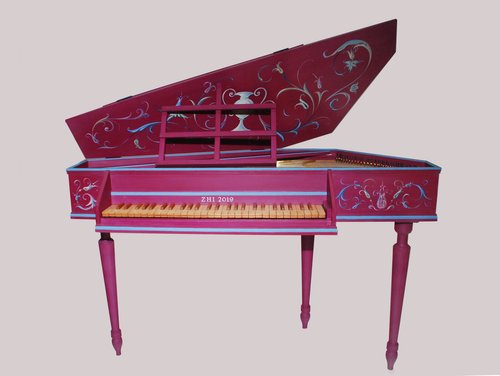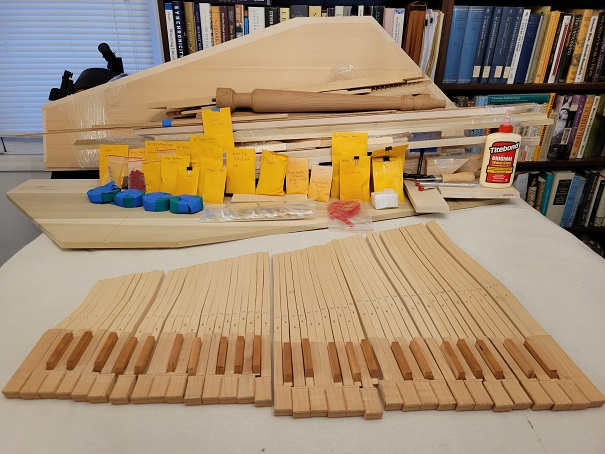2023 Project: Building a Virginal
March 3, 2023
Roscoe, N.Y.
Don’t be alarmed: A virginal is merely a compact type of harpsichord, and I hope to be building one from a kit over the next couple of months.
Blame it on Bach. Ever since I began listening to the keyboard music of Bach some 50 years ago, I’ve wanted to have a go at playing a harpsichord. It’s quite thrilling that I’ll soon be able to do this on an instrument that I’ll be building myself.
The virginal that I’ll be building is manufactured by Zuckermann Harpsichords International, who have been making harpsichord kits for well over 50 years. They call this virginal the Troubadour and this is what it should look like when it’s completed:
That photo shows the virginal sitting on a four-legged stand. I’ve opted for a three-leg option as in this photo, which shows what it might look like after being painted by someone with much more artistic flair than me:
How I will decorate my virginal is still an open question.
Here’s a three-minute promotional video from Zuckermann showing some of the construction involved in building the Troubadour and what it sound like when it’s finished:
And here’s a recent video posted by harpsichordist and musicologist Joyce Chen, who lovingly painted the Troubadour that she built:
Other videos are available that demonstrate various aspects of the construction.
The decision to plunge myself into this project didn’t come about overnight.
Ever since I started listening to Baroque music as a teenager, I’ve loved the sound of the harpsichord, and particularly the harpsichord music of Bach and Domenico Scarlatti. Historically, the harpsichord preceded the piano by several centuries. Whereas the strings (i.e., wires) in a piano are struck with a hammer and can range in volume from soft to loud — hence the name pianoforte or fortepiano from the Italian words for soft and loud — the strings of a harpsichord are plucked, which creates a fuzzier sound of uniform dynamics.
I mentioned recently, that as I approached the age of 70, I started thinking about my bucket list. I realized that although I had often seen and heard harpsichords in concerts, and have sometimes been quite close to them, I have never even touched a harpsichord, let alone played on one. Having the opportunity to play a harpsichord subsequently became the top item on my bucket list.
At first I thought I could visit a harpsichord showroom of some sort and ask if I could play for an hour or so. But I wasn’t quite sure where I would find such a place. I don’t think they even exist. Then I thought I’d take lessons. But that too fizzled out. The Lucy Moses School didn’t even answer my email inquiring about the availability of harpsichord teachers, and the web wasn’t much help. All I could find was a woman in Pennsylvania who I could reach by 2½ hours of public transportation each way, and someone from New York who was currently living in Flagstaff.
He suggested that I build my own harpsichord from a kit. I knew about harpsichord kits from way back. One of the actuaries at the insurance company where I worked out of college had built a harpsichord from a kit, and that fact was often cited as definitive proof of his eccentricity. But I immediately rejected that suggestion purely out of practical considerations. Neither our cozy New York City studio apartment nor our little house in the Catskills had room to accommodate a harpsichord.
Then I saw this video and was reminded of the virginal:
The instrument that Dr. Baldwin plays in that instructional video is also a Zuckermann virginal, but an earlier model called the Italian Virginal. The Italian Virginal was rectangular; the Troubadour Virginal that I’ll be building is polygonal.
In a conventional harpsichord, the strings are parallel to the keys, which results in an overall shape much like that of a grand piano. However, because harpsichords generally span only 4 to 5 octaves rather than the 7⅓ octaves of the piano, they’re usually less wide than pianos.
In a virginal, the strings are perpendicular to the keyboard. To accommodate those strings, the virginal is generally wider than the conventional harpsichord — as wide as a piano — but less deep. Conventional harpsichords often have multiple strings per key, and sometimes two keyboards (called manuals) but virginals are generally much simpler, with only one keyboard and one string per key (although there are some exceptions).
The origin of the name virginal is obscure. The best hypothesis is that it refers to the young ladies who traditionally played the instrument. (Sometimes the seemingly plural word virginals is used to refer to the instrument, but that just sounds weird to me.) The first citation of the word in the OED is from 1530 during the reign of Henry VIII. Both of his daughters played the virginal, and the Victoria & Albert museum has an instrument known as the Queen Elizabeth virginal. Like the Zuckermann Troubadour, it has a polygonal shape:

A virginal appears on the title page of the first printed anthology of music, which dates from 1615 and was called the Parthenia, subtitled as “The Maydenhead of the first musicke that ever was printed for the Virginalls”:
It contains music of English composers William Byrd, John Bull, and Orlando Gibbons.
Virginals are featured in no fewer than three of Vermeer’s 34 surviving paintings, the most famous being The Music Lesson, believed to have been painted between 1662 and 1665:

Although partially obscured, the Latin inscription on the inside of the virginal’s lid is “Musica lætitiæ comes medicina dolorum” and translates as “Music is a companion in pleasure and a balm in sorrow.” (An article from the Journal of the American Musical Instrument Society entitled “Harpsichord Mottoes has a list of 74 such mottoes found in historic instruments and paintings.)
This Vermeer is known as Lady Seated at a Virginal:
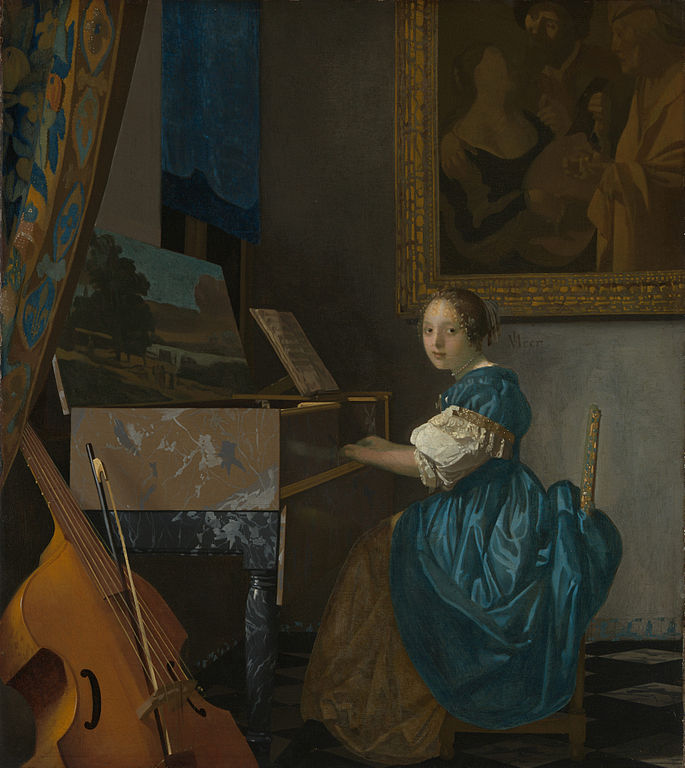
“Dude, you’re late for the rehearsal. Now pick up that viola da gamba and I hope for your sake that you’ve practiced!”
Some virginals were meant to be played standing up, as in The Music Lesson and in the third of Vermeer’s virginal paintings, Lady Standing at a Virginal:
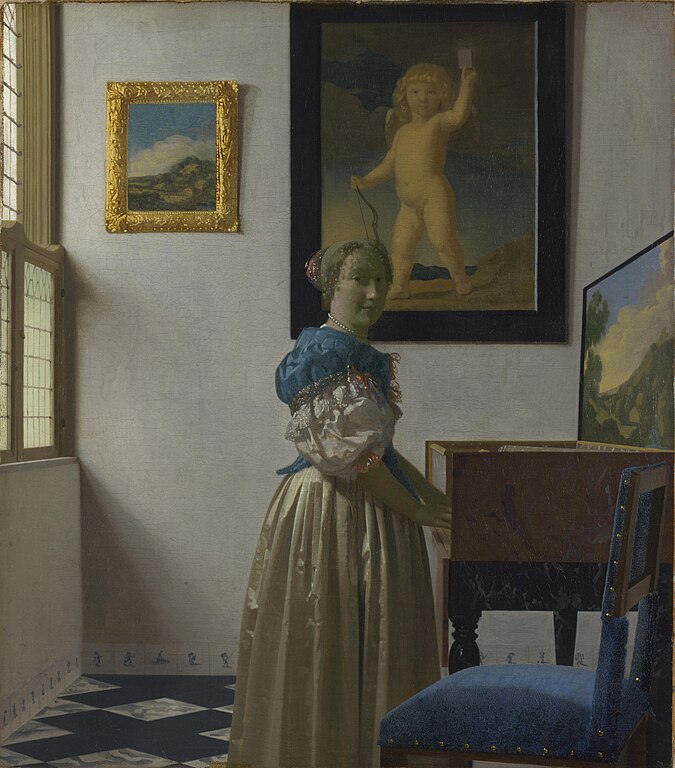
The Zuckermann Troubadour is 52” wide, which is the same width as my 88-key Yamaha Digital Piano, and it’s only 8” deeper than the Yamaha. That’s not too much of a difference, and since the Yamaha currently resides in our studio apartment where it blocks access to one of our bookcases, we figured we should be able to accommodate the Troubadour with only a little rearrangement of furniture. However, due to the quantity of sawdust (and possible loud swearing) involved in its construction, I will be building the Troubadour in our house in the Catskills.
My construction of the Troubadour will be documented in this blog but more frequently in my new Twitter feed, The Plucky Virginalist. Of course, I’m not even close to being a virginalist yet. I’ve never even touched a virginal. Here’s what my virginal looks like so far piled on our dining room table:
My hope is that it won’t meet the same fate as the harpsichord built by some friends of some friends of ours, which was abandoned early on and converted into a large planter.
What gives me confidence is that this isn’t my first project building musical instruments. Over 40 years ago I started building electronic music instruments that culminated in the computer-controlled electronic music synthesizer shown here in a photo from June 1982:
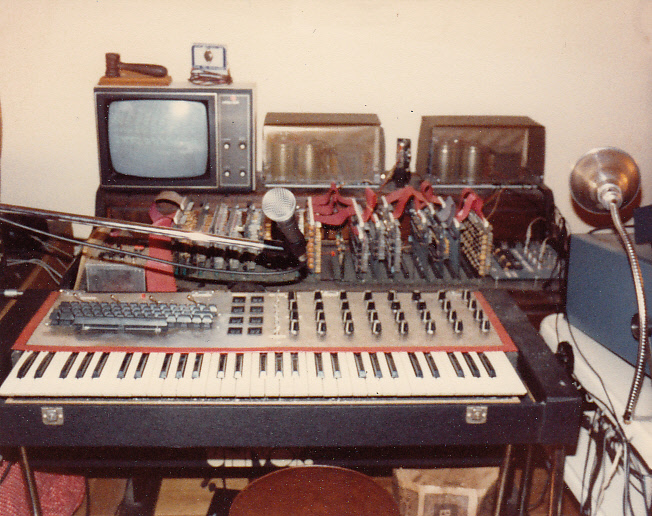
Certainly an instrument whose design dates from the 15th century can’t be much more difficult!

